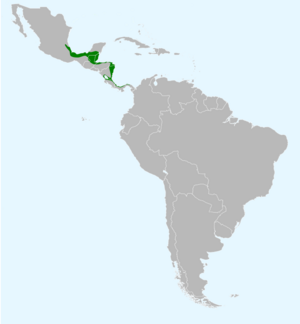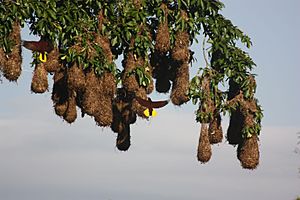Montezuma oropendola facts for kids
Quick facts for kids Montezuma oropendola |
|
|---|---|
 |
|
| feeding on wild papaya in Belize | |
| Conservation status | |
| Scientific classification | |
| Genus: |
Psarocolius
|
| Species: |
montezuma
|
 |
|
| Range of Psarocolius montezuma | |
| Synonyms | |
|
Gymnostinops montezuma |
|
The Montezuma oropendola (Psarocolius montezuma) is a large, colorful bird found in the New World tropics. It lives in the lowlands along the Caribbean coast. You can find it from southeastern Mexico all the way to central Panama. However, it is not found in El Salvador or southern Guatemala. This bird also lives on the Pacific side of Nicaragua, Honduras, and parts of Costa Rica. Its English and scientific names honor Moctezuma II, an ancient Aztec emperor.
Contents
What Does the Montezuma Oropendola Look Like?
Adult male Montezuma oropendolas are mostly a rich chestnut color. They have a blackish head and a black lower back (rump). Their tail is bright yellow, except for two dark feathers in the middle. Males have a bare blue patch on their cheek. They also have a pink fleshy part (called a wattle) near their beak. Their eyes are brown, and their long beak is black at the base with a red tip.
Female oropendolas look similar to males. However, they are much smaller. They also have a smaller wattle. Young birds are not as brightly colored as adults. Their beaks are also paler and less defined.
Size Differences Between Males and Females
Male and female Montezuma oropendolas are very different in size. This is called sexual dimorphism. A male bird is about 50 cm (20 in) long. He weighs around 520 grams (18 oz). A female is smaller, about 38 cm (15 in) long. She weighs only about 230 grams (8 oz). This means males are twice as heavy as females. This makes the Montezuma oropendola one of the most sexually dimorphic birds in the world.
The size difference helps males and females find food. Females often look for insects on thin branches. They find bugs inside curled leaves. Males usually perch on thick branches. They search for food in plants like epiphytes and bromeliads.
Male Behavior and Calls
While females are busy nesting, males often fight each other. They compete to be the strongest male in the group. The strongest male, called the alpha male, usually chases away other males. He stays until he is the only one left. When the alpha male leaves, other males return to protect the females. This way of mating is similar to how some mammals behave.
The male Montezuma oropendola has a very special song. It sings this song during a bowing display. The song starts with soft, bubbling sounds. Then it gets louder with gurgles, sounding like tic-tic-glik-glak-GLUUuuuuu. Both male and female birds also make loud cack and crrrk calls.
Where Do Montezuma Oropendolas Live?
The Montezuma oropendola is a common bird in many parts of its home range. They are omnivores, meaning they eat both plants and animals. They often fly in small or large groups. They search for food in trees. Their diet includes small animals, large insects, nectar, and fruits. They enjoy bananas, Cecropia spikes, gumbo-limbo trees, and Trophis racemosa fruits. When it's not breeding season, these birds move around quite a bit.
Montezuma oropendolas live in forest canopies and at the edges of forests. They also like old plantations.
Nesting and Reproduction
These birds are colonial breeders. This means they build their nests together in large groups. Only the females build the nests. They weave long, hanging nests from plant fibers and vines. These nests can be 60 to 180 cm (24 to 71 in) long. They hang high up in trees, sometimes 30 meters (98 ft) off the ground.
Each colony has one dominant male. This male mates with most of the females after a special bowing display. The female lays two eggs. The eggs are white or buff with dark spots. She sits on the eggs alone until they hatch in about 15 days. The young birds leave the nest (fledge) after about 30 days. While in the nest, baby birds are fed spiders, other insects, frogs, lizards, and fruits. A colony usually has about 30 nests. However, some colonies have been seen with as many as 172 nests!
How Montezuma Oropendolas Interact with Other Birds
The chestnut-headed oropendola lives in many of the same areas. However, it is smaller and mostly black with a chestnut head. The Montezuma oropendola is mostly chestnut with a black head. It also has colorful patches on its face. Because of these differences, it's easy to tell the two species apart.
Unlike some other birds, Montezuma oropendolas do not like brood parasites near their nests. A brood parasite is a bird, like the Giant cowbird, that lays its eggs in another bird's nest. This makes the other bird raise the parasite's young. Female Montezuma oropendolas actively protect their nests from Giant Cowbirds. They attack the cowbirds and make them leave the colony. Females only defend their own nests, not the whole colony.
Montezuma oropendolas do not nest near social wasps or bees. This is different from some other oropendola species. Because they don't nest near these insects, they don't have protection against botflies. Botflies can harm young birds in the nest. The success rate for Montezuma oropendola nests is quite low. Females lay two eggs, but usually only one chick survives to fledge. Only about one-third of the nests in a colony are successful. Because of this low success rate, having brood parasites around is too risky for these birds.



